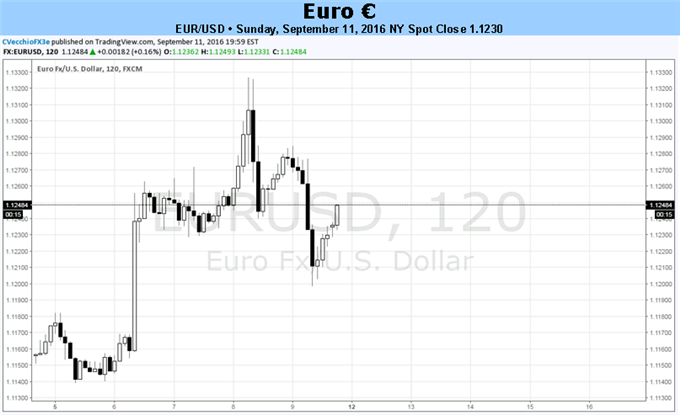
Fundamental Forecast for Euro: Neutral
- EUR/USD has been lifted by weakness on the USD side, not strength on the EUR side.
- ECB President Draghi made clear
- Volatility in FX markets is due to rebound over the coming weeks – it’s a good time to review risk management principles.
To receive reports from this analyst, sign up for Christopher’s distribution list.
In a week when global equity markets were hit hard after weeks of low volatility and stability, it’s of little surprise that the Euro emerged as a top performer; after all, it is a low yielding funding currency, a safe haven, if you will, during times of market stress/demand for liquidity. The performances by the other major currencies offer support to this view. The Japanese Yen, the prototypical safe haven, was the top performer overall, while two of the commodity currencies, the Australian and Canadian Dollars, were the two laggards.
On the surface, then, given the Euro’s docile performance, it may seem safe to assume that Thursday’s European Central Bank rate decision and press conference came and went without any meaningful developments – that is hardly the case. To be clear, it very much seems that ECB President Mario Draghi used his press conference to start to pave the runway for more easing by the end of 2016; a reading of the ECB’s tea leaves reveals as much.
While we may have jumped the gun in our anticipation of the ECB tweaking its QE program back in July (one meeting early), ECB President Draghi made clear that our exact concerns are now being addressed by the ECB. What were they? A refresher on the ECB’s “capital key” is necessary. What is the capital key? The capital of the ECB comes from the national central banks (NCBs) of all EU member states. According to the ECB, the NCB’s shares in this capital are calculated using a key which reflects the respective country’s share in the total population and gross domestic product of the EU.
ECB President Draghi made clear on Thursday that the effectiveness of the QE program may be challenged given the constraints the capital key now poses. “We tasked the relevant committees to work on the smooth implementation and the changes that are needed to ensure the smooth implementation,” he said. In other words, the ECB is not focused on the size of the QE program right now, but rather, whether or not its functioning properly.
As we wrote in July, which bears repeating now after ECB President Draghi’s commentary, “it's no surprise that Germany - as the country with the largest capital key contribution - has seen the belly of its yield curve (3Y-7Y) drift lower into negative territory, below the ECB's -0.40% deposit level - the threshold at which the ECB no longer purchases bonds in its QE program. Likewise, the ECB needs to either: remove the limiting parameter of -0.40% on its bond buying; or discard the capital key variable. In the first case, German yields would like move lower the fastest; in the second, peripheral yields.”
Seeing as how the ECB did little to adjust its growth and inflation forecasts at its September policy meeting, there doesn’t seem to be significant motivation to act as soon as the next rate decision. Rather, with a few months under their belt, the “relevant committees” may have determined, in context of new staff economic projections, that a QE adjustment is appropriate in December.
That would make the most sense, considering the ECB is one among the many central banks that is dealing with a credibility crisis. As such, in an effort to be transparent, it has become predictable; the ECB, like the Fed and the BOE, has only acted at meetings in which new growth and inflation forecasts have been produced, as a way to justify their new stance in monetary policy.
It’s important to put all of this in context of recent developments, because ECB President Draghi hasn’t been the only policymaker hinting at more action to come. As we highlighted two weeks ago, European Central Bank Executive Board member Benoit Coeure, at the Jackson Hole Economic Policy Symposium, said “if other actors do not take the necessary measures in their policy domains, we may need to dive deeper into our operational framework and strategy to do so.” We know the likely reality is that ‘politicians aren’t going to stop fooling around, so the ECB will ease again.’
As reality sets in, interest rate markets will have to pull forward rate cut expectations (OIS currently sitting at approximately 32%), helping drive down the Euro broadly. With the Fed and BOJ rate decisions just around the corner (September 20-21), these overarching ECB influences on the Euro may not be prominent or reveal themselves for several weeks. Nevertheless, the subtle shifts in ECB signaling over the past few weeks, culminating in the ECB’s policy decision on Thursday, lead us to the conclusion that we have not seen the last wave of ECB easing in 2016.–CV
To receive reports from this analyst, sign up for Christopher’s distribution list




